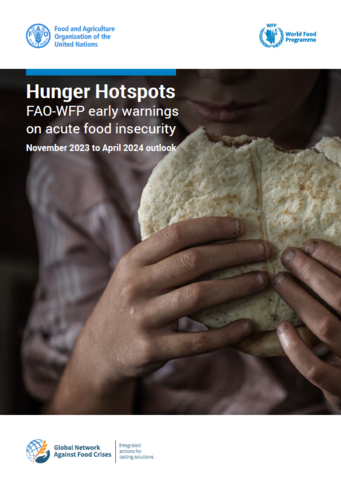Hunger Hotspots report launched by the Food and Agriculture Organization of UN and the World Food Programme (WFP).
The Hunger Hotspots report by WFP and FAO identifies 18 hunger “hotspots” in a total of 22 countries where food security is expected to significantly deteriorate, and the outlook for the next six months from November 2023 to April 2024.
The release of the October 2023 Hunger Hotspots report by the World Food Programme (WFP) and the Food and Agriculture Organization (FAO) demonstrates the complexity and interaction of conflict, climate impacts, economic shocks in key contexts by assessing the food security outlook for the next six months from November 2023 to April 2024.
The report identifies 18 hunger “hotspots” in a total of 22 countries or territories where it is expected a significant deterioration of the already high levels of acute food insecurity, putting lives and livelihoods at stake.
The report is a significant resource for the humanitarian community and WFP and FAO, in particular, to provide country-specific recommendations on priorities for anticipatory action and emergency response to address existing and emerging humanitarian needs.
Key Highlights of Hunger Hotspots report
- Burkina Faso, Mali, South Sudan and the Sudan remain at the highest concern level. Palestine was added to the list of countries/ territories of highest concern due to the severe escalation of conflict in October 2023.
- Afghanistan, the Democratic Republic of the Congo, Ethiopia, Haiti, Pakistan, Somalia, the Syrian Arab Republic and Yemen are hotspots of very high concern. All these hotspots have a high number of people facing or projected to face critical levels of acute food insecurity.
- Since the May 2023 edition, Chad, Djibouti, the Niger, Palestine and Zimbabwe have been added to the list of hunger hotspot countries/ territories, while the countries in the Dry Corridor of Central America (El Salvador, Guatemala, Honduras and Nicaragua) and Malawi remain hunger hotspot countries.
- The countries/territories and situations covered in this report highlight the most significant deteriorations of hunger expected in the outlook period, but do not represent all countries or territories with high levels of acute food insecurity.
- Ongoing or planned reductions and gaps in emergency agriculture, food and livelihood assistance affect several hunger hotspots of very high concern and highest concern, such as Afghanistan, Haiti, Palestine, Somalia, the Syrian Arabic Republic and Yemen, other hunger hotspots, such as Malawi, and countries or situations that require monitoring, such as Uganda and Cox’s Bazar (Bangladesh).
- Weather extremes, such as heavy rains, tropical storms, cyclones, flooding, drought and increased climate variability, remain significant drivers of acute food insecurity in some countries and regions.
- Urgent and scaled-up assistance is required in all 18 hunger hotspots to protect livelihoods and increase access to food. This is essential to avert a further deterioration of acute food insecurity and malnutrition. In the hotspots of highest concern, humanitarian actions are critical in preventing further starvation and death.
This report provides country-specific recommendations on priorities for emergency response, as well as anticipatory actions to address existing humanitarian needs and ensure short-term protective interventions before new needs materialize.

